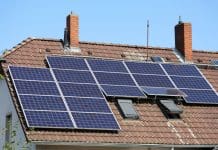Dr Jon Hiscock, CEO of Fundamentals Limited, explores the challenges of keeping the power on in the race to low carbon electricity
It is beyond argument that clean electricity is the key driver for achieving net zero carbon. But the UK power cuts of November 2021 are a stark reminder that all-electric buildings and systems have an Achilles heel. When the power trips out, nothing works unless there is a backup supply.
As storms devastated parts of the electricity distribution infrastructure, thousands of homes and businesses found themselves powerless for days or weeks. Even those with gas or oil central heating found that with no electricity, their pumps could not function. The lucky ones had old school gas for heating and cooking, plus solid fuel fires. All-electric converts froze in the dark.
The 2021 outages raise some very big questions in terms of how electricity systems work, and how electricity is used. As we increasingly rely on electricity, extreme weather events causing storms and floods are likely to proliferate. We need to be prepared.
Backup power
Designers of larger buildings and electricity-reliant systems have long recognised the necessity for backup power supplies, traditionally from diesel generators. Interesting green alternatives include very large batteries, compressed air storage, flywheels and gravity-based kinetic energy generators – few of which are mainstream yet.
But domestic and smaller users without the options above face a dilemma. They will inevitably be torn between going all-electric for environmental (and increasingly economic) reasons, or hanging onto fossil fuelled systems for security. And the gas boiler option will soon disappear for new builds.
Part of the answer is domestic-scale battery storage, either charged from the grid on smart tariffs when electricity is cheap, or from on-site solar or wind. But batteries are expensive (albeit falling in price). They need to be integrated with the building’s systems to act as emergency supplies, which is currently not always the case. And unless they are large, they will only provide enough power for short periods for lighting, central heating pumps and basic equipment.
It still makes absolute sense to design new small builds for an all-electric future, with fully integrated heat pumps, battery storage and EV charging as standard. But we need to look further to address their vulnerability to power cuts. And the cost and engineering resources to retrofit these technologies to millions of homes remains the elephant in the room.
Avoiding power cuts
Power cuts have many causes. Some are predictable and avoidable. Some are genuinely ‘Acts of God’. But prevention is better than cure.
The power cut which blacked out the central business district of Auckland, New Zealand, for five weeks in 1998 was a perfect example of ‘predictable and avoidable’. The whole district was served by just two critical power cables, which were more than 40 years old, under-specified and not checked for signs of failure. When one cable blew, it over-loaded the second and the whole power system failed catastrophically, with no Plan B in place. The event had a profound effect on New Zealand’s economy and proved a wake-up call for the electricity industry worldwide.
The good news is that systems for preventing such failures have advanced dramatically in the last 24 years, in the UK and elsewhere. Wires, cables and substations across the grid are actively monitored to identify faults as they start to develop. Long before they escalate into failures and outages, assets can be repaired or replaced. Grid operators have developed sophisticated methodologies for viewing the health of every part of their networks and prioritising interventions, based on the risks of failure.
The technologies used to predict and prevent outages in the transmission and distribution networks are also being applied by Private Network Operators (PNOs) – the people who run the large, electricity-hungry systems that drive everything from process and manufacturing industries, to transport and health infrastructures. Visibility of the condition of assets, together with targeted interventions, are the keys to reliable electricity supplies.
Designing for disaster
Japan’s Fukushima nuclear disaster in 2011 was a warning that, when designing for worst case scenarios, some can be even worse that expected. The earthquake did not damage the reactors themselves. But failure of the grid electricity which ran the cooling pumps meant the plant was reliant on backup diesel generators. These were knocked out by a 14 metre tsunami which flooded their compound – far higher than the specifiers had expected. The resulting meltdown caused one of the worst civilian nuclear disasters in history – and profoundly dented faith in safe nuclear power.
The UK’s November 2021 power cuts were not caused by a single local event, but by widespread devastation of whole regional electricity distribution networks. Hundreds of poles were snapped, trees and debris took out overhead wires, buildings were damaged. Much of the carnage occurred in remote rural locations which presented engineers with enormous challenges of logistics and access.
Conventional planning for such eventualities is based on models that include ‘100 year storms’ and ‘1000 year disasters’. But the probability that extreme weather events will cause events of greater frequency and severity means we need to be ready. As various commentators have said in relation to UK flooding: ‘funny how these 100 year storms seem to be happening every year now’.
Of course it is impossible to provide a 100% guarantee of uninterrupted electricity for all. The transmission and distribution grids will always be vulnerable to anything from falling trees and careless digger drivers, to criminal damage and terrorism. Realistic disaster planning, backed by better infrastructure design, smarter monitoring and maintenance, all play their part in keeping disruption to an absolute minimum.
Now the good news
Latest government analyses confirm that it is already cheaper to generate electricity from wind and solar power (WASPs) than gas, coal and nuclear – and the advantage in favour of low carbon power will continue to grow in the years ahead.
But the cry goes up: ‘What happens when the wind doesn’t blow and the sun doesn’t shine? And how will the system cope when millions of electric cars and heat pumps are plugged in?’ People are worried that the electricity system will become overloaded and fail. We don’t think this will happen, for a whole range of reasons.
There is no single solution to these challenges. Rather, there are multiple strategies and innovations being implemented across the electricity sector. Viewed together, they make up a radical change in the way electricity is produced, distributed and used.
On a global level, inter-connects are one of the most exciting innovations to overcome the challenge of intermittent renewable generation. When it is cloudy and windless in the North Sea, the sun will be shining on a windy day in Spain – and vice versa on different days. Connecting up the renewable power sources worldwide will contribute dramatically to load balancing.
There are some areas of uncertainty, including the role of nuclear and the provision of reserve capacity to replace unexpected losses of major power plants. Set against those, there is the prospect of using surplus renewable power to produce green hydrogen as a direct replacement for fossil fuels.
Getting smarter
National Grid is planning for 11 million EVs by 2030 – up from fewer than 600,000 now. That’s not just 11 million drains on power – viewed another way it is 11 million electrical storage devices, potentially supplemented by millions more backup batteries in homes and larger buildings. Other contributors to the system include pumped water storage, which has already been operating in North Wales for more than 60 years, originally to store surplus power from nuclear plants.
Using smart technology, each of these devices can be charged at different times, when electricity is plentiful and cheap. They can also be called upon to provide some of their stored energy, when demand is at its peak and expensive. The technology to do this already exists and is showing excellent results in some areas. Rolling it out nationwide could not only play a part in balancing supply and demand. It could save customers money.
For our own part, we are working with distribution network companies to provide technologies which are linked to smart meters, controlling grid voltages automatically when EVs are plugged in. This ensures the network is protected from overloads which can cause outages.
Build the future now
Every new building and refurbishment project should be designed on the basis that they will be part of an all-electric future (albeit that diesel generators, ideally bio-fuelled, will still be needed in many applications). That means electric HVAC for every premises, including houses, with integrated battery storage systems and plentiful EV charge points, all connected to the grid by smart meters. And we can expect electricity companies to have a far more proactive relationship with customers, to manage power usage more intelligently and at lowest cost.
Future power cuts are unlikely to be caused by poor grid management or lack of generating capacity. Scenario planning for extreme events is improving all the time. But as the 2021 storms showed, no amount of planning can eliminate risk entirely. We need to be as prepared as realistically possible – but always expect the unexpected.













